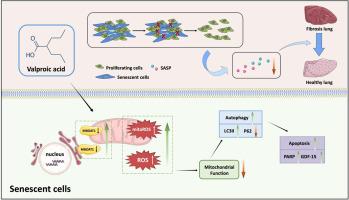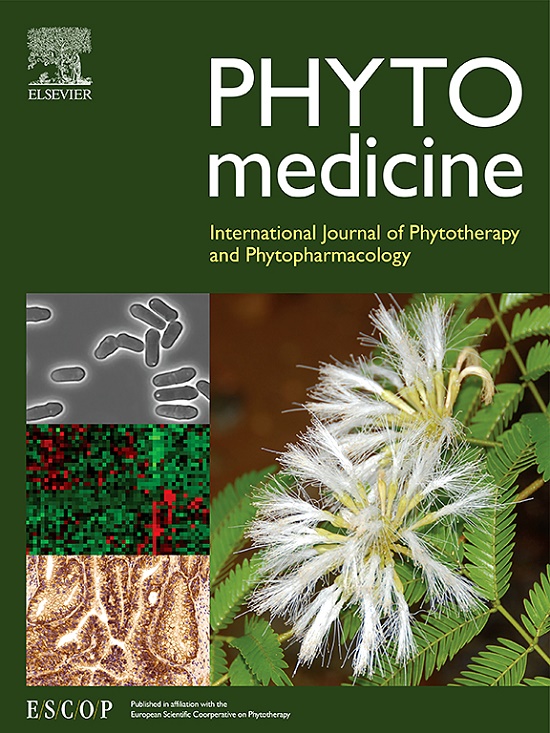丙戊酸靶向凋亡衰老细胞,缓解治疗诱导的细胞衰老和肺衰老
IF 6.7
1区 医学
Q1 CHEMISTRY, MEDICINAL
引用次数: 0
摘要
背景衰老细胞在组织中的积累及其下游效应程序已成为衰老和年龄相关病症的关键驱动因素。最近在衰老治疗方面取得的进展表明,使用衰老溶解剂选择性地杀死衰老细胞或使用衰老修饰剂抑制衰老相关分泌表型(SASP)的分泌,有助于延长小鼠的健康寿命并缓解多种与年龄相关的疾病。方法通过衰老相关的 β-半乳糖苷酶(SA-β-Gal)染色法、流式细胞术和免疫印迹法(WB)评估丙戊酸(VPA)(一种缬氨酸的衍生物)对细胞衰老的影响。使用 CCK-8 试剂盒检测细胞活力。Annexin V-EGFP/PI 细胞凋亡检测试剂盒检测细胞凋亡。使用 GFP-RFP-LC3 比率质粒检测细胞自噬。结果我们发现VPA能诱导衰老细胞活性氧(ROS)过度积累(增加1.5倍)和凋亡(增加2倍)。从机理上讲,VPA激活了衰老过程中被抑制的磷脂修饰酶膜结合O-酰基转移酶域含蛋白1(MBOAT1),然后促进了线粒体自噬和细胞凋亡。此外,研究还发现 VPA 还能缓解治疗诱导的线粒体异常和体内肺衰老表型(肺纤维化标志物减少 1.5 倍,幼稚/记忆 CD4+ 或 CD8+ T 细胞增加 2.5 倍)。结论综上所述,我们的研究表明 VPA 能够在体外和体内选择性地杀死衰老细胞,从而揭示了 VPA 在抗衰老和抗老年相关疾病方面的新功能和新的潜在应用。本文章由计算机程序翻译,如有差异,请以英文原文为准。

Targeted apoptosis of senescent cells by valproic acid alleviates therapy-induced cellular senescence and lung aging
Background
Accumulation of senescent cells in tissues and their downstream effect programs have emerged as key drivers of aging and age-associated pathologies. Recent progresses in senotherapeutics indicated that either selectively killing senescent cells with senolytics or suppressing the senescence-associated secretory phenotype (SASP) secretion using senomorphics contributes to extending of the healthy lifespan and alleviating numerous age-related disorders in mice.
Purpose
However, the potential side-effects and long-term cytotoxicity of the above novel compounds have not yet been determined. Therefore, it seems to be more efficient to explore new senotherapeutical functions from approved drugs.
Methods
The effects of valproic acid (VPA), a derivative of valine, in cellular senescence were evaluated by senescence-associated β galactosidase (SA-β-Gal) staining, flow cytometry and western blot (WB). The cell viability was tested using CCK-8 kits. Cell apoptosis was detected by Annexin V-EGFP/PI apoptosis detection kit. Cell autophagy was checked using GFP-RFP-LC3 ratiometric plasmid. The roles of VPA in lung aging were investigated by in vivo experiments using H&E and Masson staining, WB, as well as electronic microscope strategies.
Results
Here we identified VPA was able to induce an over-accumulation of reactive oxygen species (ROS) (>1.5 times increasing) and apoptosis (>2 times increasing) of senescent cells. Mechanistically, VPA activated the phospholipid modifying enzyme membrane-bound O-acyltransferase domain-containing protein 1 (MBOAT1), which was repressed during senescence, then promoted mitochondrial autophagy and apoptosis. In addition, VPA was also found to alleviate therapy induced abnormal mitochondria and lung aging phenotype (>1.5 times decreasing of lung fibrosis markers and >2.5 times increasing of naïve/memory CD4+ or CD8+ T cells) in vivo.
Conclusion
Taken together, our study demonstrated that VPA was able to selectively kill senescent cells both in vitro and in vivo, and thus shedding light on new functions and novel potential application of VPA in anti-aging and anti-age-associated diseases.
求助全文
通过发布文献求助,成功后即可免费获取论文全文。
去求助
来源期刊

Phytomedicine
医学-药学
CiteScore
10.30
自引率
5.10%
发文量
670
审稿时长
91 days
期刊介绍:
Phytomedicine is a therapy-oriented journal that publishes innovative studies on the efficacy, safety, quality, and mechanisms of action of specified plant extracts, phytopharmaceuticals, and their isolated constituents. This includes clinical, pharmacological, pharmacokinetic, and toxicological studies of herbal medicinal products, preparations, and purified compounds with defined and consistent quality, ensuring reproducible pharmacological activity. Founded in 1994, Phytomedicine aims to focus and stimulate research in this field and establish internationally accepted scientific standards for pharmacological studies, proof of clinical efficacy, and safety of phytomedicines.
 求助内容:
求助内容: 应助结果提醒方式:
应助结果提醒方式:


